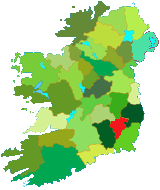County
Carlow from Samuel Lewis' Topographical
Directory of Ireland 1837
Carlow the name
comes from the Irish Ceatharlach (four lakes).It has
an area of 896 sq. Km (346 sq mi).
making it the second smallest county in Ireland, it
is situated in the Provence of Leinster, in the Southeast
of Ireland. Carlow's fertile soils make it ideal for
mixed agriculture. Arable crops are more important here
than in most other Irish counties, accounting for one
third of farm output. The crops are mainly cereals and
sugar beet. Most cattle are reared and fattened for
beef, but there is some dairying. Sheep farming is important,
especially in the upland areas of the east of the county.
Farms average about 30 hectares in area and are larger
than most other farms of Ireland. Farmers in the lowlands
of Carlow grow cereals, potatoes, sugar beet, and other
crops.
The river Barrow
flows southward through the county forming the western
boundary with County Kilkenny along part of its course,
the valley of the Barrow has a limestone floor. The
lowland area in the Northeast sits on granite. The River
Slaney flows southeastward toward Wexford Harbour. Most
of Carlow is a flat with undulating lowland, the land
rises to the east and west. Along the eastern edge are
the Blackstairs Mountains.
Carlow and Kilkenny jointly send
five Td's to Dail Eireann A county council based in
Carlow administers the county's local government.
Ireland's first sugar beet refining
factory, built in 1926, was a great boost to industrial
development. Most of the factories are modern. They
produce tools, machinery, and precision instruments.
Other industries include meat processing in Hacketstown
and Bagenalstown, machinery in Bagenalstown and Borris,
and saw milling near Tullow. An important part of Carlow's
manufacturing industry is processing agricultural output
and timber, and supplying the needs of farmers. Half
the manufacturing workforce is employed in the metal
and engineering industries and a further quarter in
food processing. |


